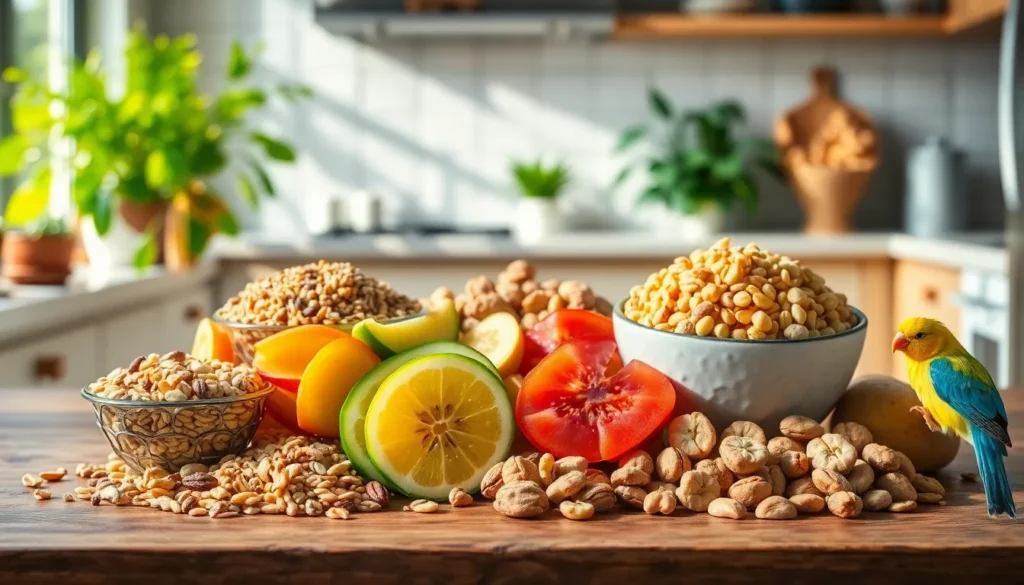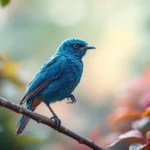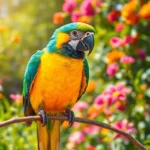We all know that happy birds are healthy birds and the secret lies in providing them with the right treats. Just like humans enjoy occasional snacks bird treats serve as more than simple rewards – they’re essential tools for bonding training and enriching your feathered friend’s daily routine.
Finding the perfect treats for your bird can feel overwhelming with countless options lining pet store shelves. From nutrient-packed seed mixes to homemade fruit combinations each type offers unique benefits for your bird’s physical health and mental stimulation. The key is understanding which treats work best for your exact bird species and their individual preferences.
We’ve spent years researching and testing various bird treats to help you make informed decisions that’ll keep your feathered companion thriving. Whether you’re looking to reward good behavior encourage foraging instincts or simply show your bird some extra love the right treats can transform your relationship and boost their overall well-being.
Seed-Based Bird Treats for Daily Nutrition
Seeds form the foundation of most birds’ natural diets and provide essential nutrients for optimal health. We’ve discovered that offering the right seed based treats keeps our feathered friends satisfied while supporting their nutritional needs throughout the day.
Sunflower Seeds for Energy and Health
Sunflower seeds deliver high energy content and essential fats that support our birds’ active lifestyles. These popular treats contain vitamin E, healthy oils, and protein that promote strong feather development and robust immune systems. Black oil sunflower seeds offer the highest fat content, making them ideal for larger birds like cardinals, blue jays, and woodpeckers.
Striped sunflower seeds work well for medium sized birds such as chickadees and nuthatches. We recommend offering sunflower seeds in moderation since their high fat content can lead to weight gain if overfed. Most birds crack these seeds naturally, providing mental stimulation alongside nutritional benefits.
Millet Sprays for Natural Foraging
Millet sprays encourage natural foraging behaviors while delivering important carbohydrates and B vitamins. These long lasting treats keep birds engaged for extended periods as they work to extract individual seeds from the spray. Cockatiels, budgies, and canaries particularly enjoy millet sprays, often hanging upside down to reach every seed.
White proso millet contains easily digestible proteins and minerals like magnesium and phosphorus. We’ve found that hanging millet sprays at different heights creates enriching feeding opportunities that mimic wild foraging experiences. Fresh millet sprays maintain better nutritional value than processed alternatives, though both options provide valuable dietary supplements.
Nyjer Seeds for Finches and Small Birds
Nyjer seeds attract goldfinches, siskins, and other small songbirds with their rich oil content and compact size. These tiny black seeds contain omega fatty acids that support healthy skin and vibrant plumage colors. Specialty nyjer feeders with small ports prevent larger birds from dominating the food source while allowing finches easy access.
Thistle seeds require exact storage conditions to maintain freshness since their high oil content can turn rancid quickly. We store nyjer seeds in cool, dry locations and replace them every few months to ensure optimal quality. Mixed nyjer and canary seed blends provide variety for small birds while maintaining the nutritional benefits both species need.
Fruit-Based Bird Treats for Natural Sweetness
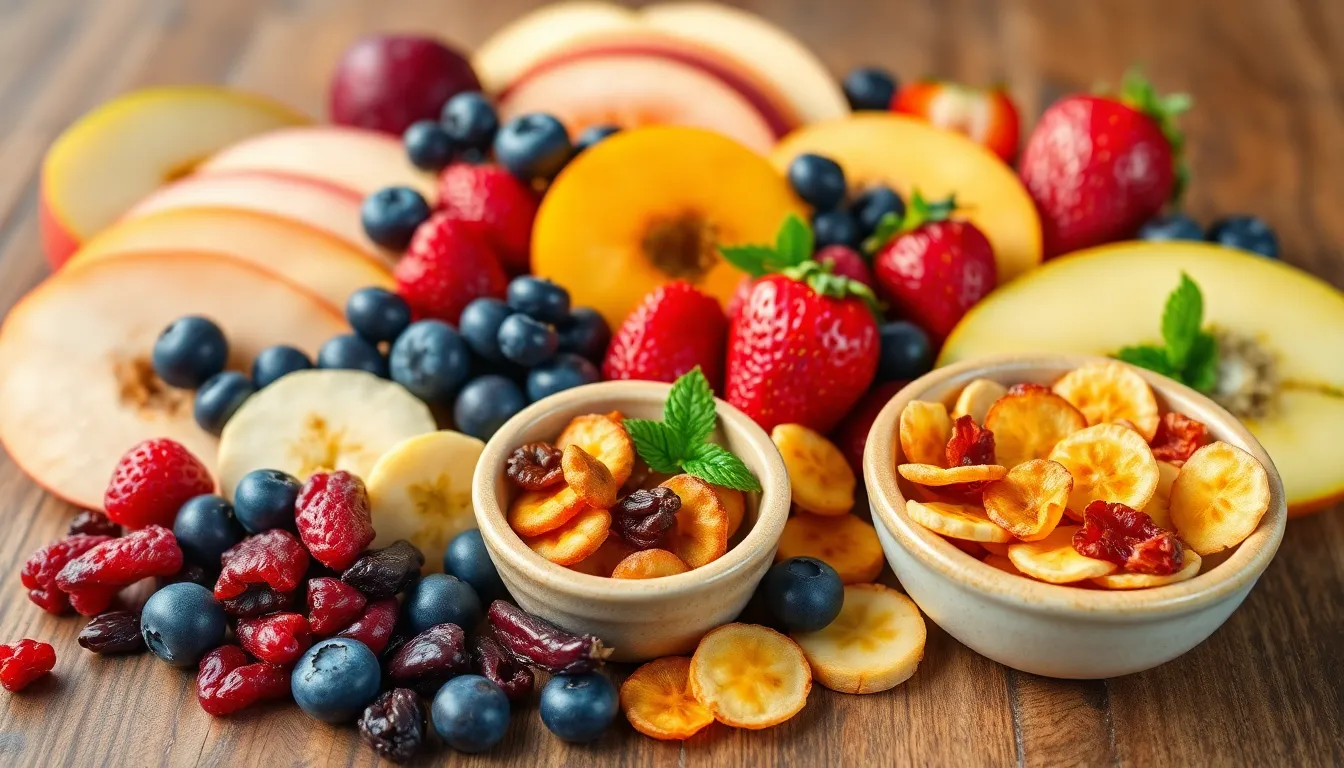
Fruit treats provide natural sugars and essential vitamins that birds crave. We’ve discovered these nutritious options offer perfect alternatives to processed treats while supporting optimal health.
Fresh Apple Slices and Berries
Apple slices deliver vitamin C and fiber that boost immune systems in most bird species. We remove seeds before serving since apple seeds contain compounds that can harm birds. Cutting apples into appropriate sizes prevents choking while encouraging natural pecking behaviors.
Blueberries pack antioxidants and natural sugars that finches, cockatiels, and parrots absolutely love. These small berries fit perfectly in beaks of various sizes without requiring preparation. Fresh strawberries offer vitamin C and natural sweetness that larger birds like African greys and macaws eagerly consume.
Raspberries provide natural fiber and essential nutrients while satisfying birds’ desire for textured foods. We’ve observed that blackberries create captivating foraging experiences as birds work to extract the small drupelets. Both berries should be offered fresh and thoroughly washed to remove potential pesticide residues.
Dried Fruit Mixes Without Added Sugar
Unsweetened dried cranberries offer concentrated nutrition without harmful additives that commercial treats often contain. We select brands specifically labeled “no sugar added” to ensure birds receive only natural fruit sugars. These tart treats work especially well mixed with seeds for balanced nutrition.
Dried papaya pieces provide digestive enzymes and vitamin A that support healthy feather development. Natural drying processes preserve nutrients while creating chewy textures that birds find satisfying. We’ve found that soaking dried fruits briefly in water can make them easier for smaller birds to consume.
Dehydrated banana chips appeal to fruit-loving species like lovebirds and conures when prepared without oils or sweeteners. Homemade versions ensure quality control while eliminating preservatives found in commercial products. Sun-dried raisins offer natural iron and potassium that support overall health when given in moderation.
Seasonal Fruit Options for Variety
Spring brings fresh cherries that provide natural melatonin and antioxidants beneficial for bird health. We remove pits completely since cherry stones contain toxic compounds similar to apple seeds. Sweet cherries work better than tart varieties for most bird preferences.
Summer melons like cantaloupe and honeydew offer high water content that helps with hydration during hot weather. These fruits contain beta-carotene and vitamin C while providing natural cooling effects. We cut melon into appropriate sizes and remove all seeds before serving.
Fall harvest fruits including pears and grapes create seasonal excitement in bird diets. Pears should be served fresh with seeds removed, while grapes can be halved for smaller birds to prevent choking. Winter citrus fruits like oranges provide vitamin C boosts when other fresh options become limited, though we offer these sparingly due to their acidity.
Nut-Based Bird Treats for Protein Power
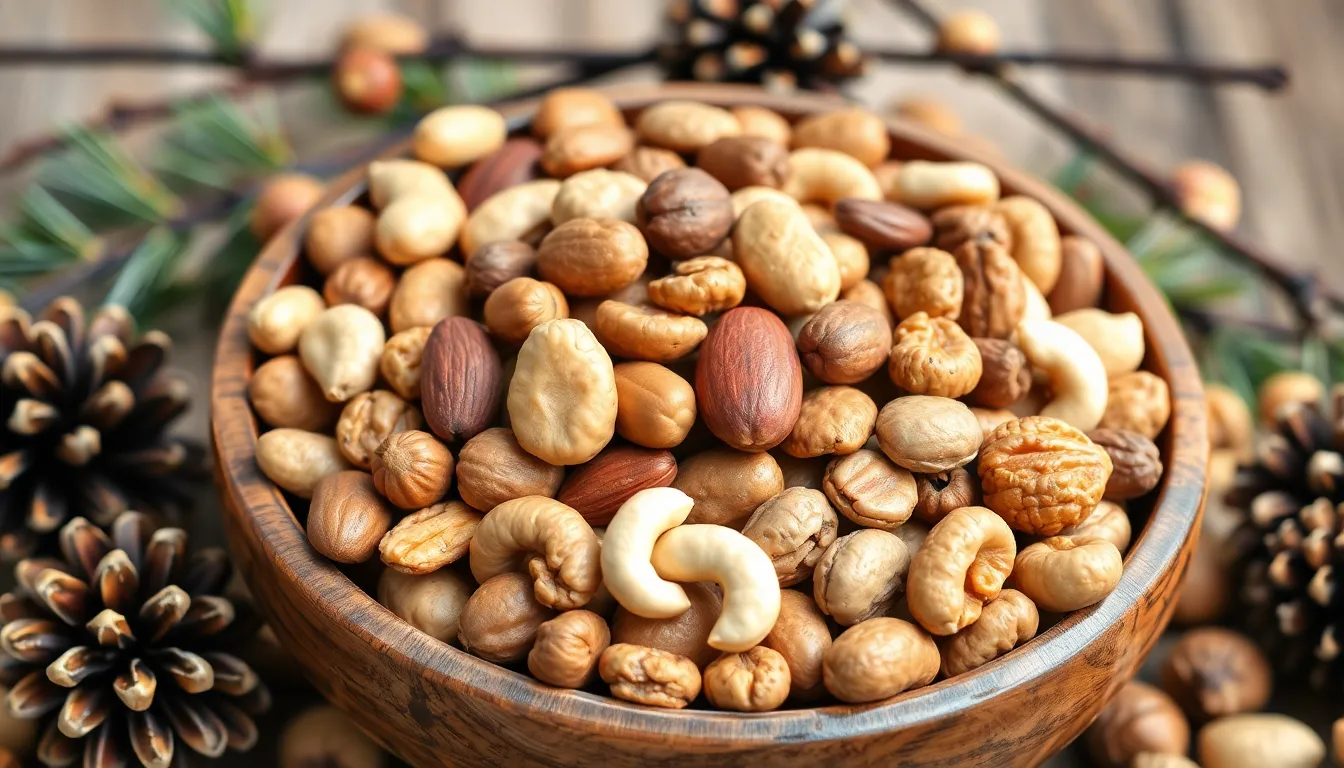
Nuts deliver concentrated protein and healthy fats that support muscle development and feather health in birds. We’ve discovered that these nutrient-dense treats work especially well for larger species like macaws, cockatoos, and African greys.
Unsalted Peanuts and Tree Nuts
Unsalted peanuts provide exceptional protein content while offering mental stimulation through their tough shells. We recommend offering raw peanuts in shells to encourage natural foraging behaviors, particularly for larger parrots who enjoy the challenge of cracking them open. Almonds work wonderfully for medium to large birds, delivering vitamin E and magnesium that support immune function.
Walnuts contain omega-3 fatty acids that promote brain health and glossy feathers. We suggest breaking larger nuts like Brazil nuts and pecans into smaller pieces for safety and easier consumption. Cashews offer a softer texture that appeals to birds with smaller beaks, while hazelnuts provide a perfect size for cockatiels and conures.
Always avoid salted, flavored, or chocolate-coated nuts as these can harm your bird’s digestive system. Store nuts in airtight containers to prevent rancidity and maintain their nutritional value for up to six months.
Nut Butter Spreads on Natural Surfaces
Nut butter spreads create captivating foraging opportunities when applied to natural surfaces like pine cones or apple branches. We spread unsalted peanut butter or almond butter thinly on these surfaces to encourage natural pecking and climbing behaviors. Tree branches work particularly well as they provide both nutrition and physical exercise for your birds.
Almond butter offers a different flavor profile while delivering similar protein benefits to peanut butter. We’ve found that cashew butter appeals to birds who prefer milder tastes, making it an excellent introduction treat for pickier eaters. Sunflower seed butter serves as a nut-free alternative for birds with sensitivities.
Apply these spreads sparingly to avoid overconsumption of fats, and always choose products without added salt, sugar, or xylitol. Fresh application works best as nut butters can spoil quickly in warm environments.
Chopped Nuts for Easy Consumption
Chopped nuts provide convenient portion control while reducing choking hazards for smaller birds. We dice almonds, walnuts, and pecans into pieces roughly the size of your bird’s beak opening to ensure safe consumption. Finely chopped hazelnuts work perfectly for budgies and cockatiels, while larger chunks suit bigger species.
Mixed chopped nuts offer variety and prevent boredom during treat time. We combine chopped almonds with walnuts and a small amount of pine nuts to create a balanced protein mix. Macadamia pieces work well for special occasions, though their high fat content requires moderation.
Freshly chopped nuts maintain better flavor and nutritional value than pre-packaged options. Store chopped nuts in refrigerated containers for up to two weeks, or freeze portions for longer storage without losing their protein power benefits.
Vegetable Bird Treats for Essential Vitamins
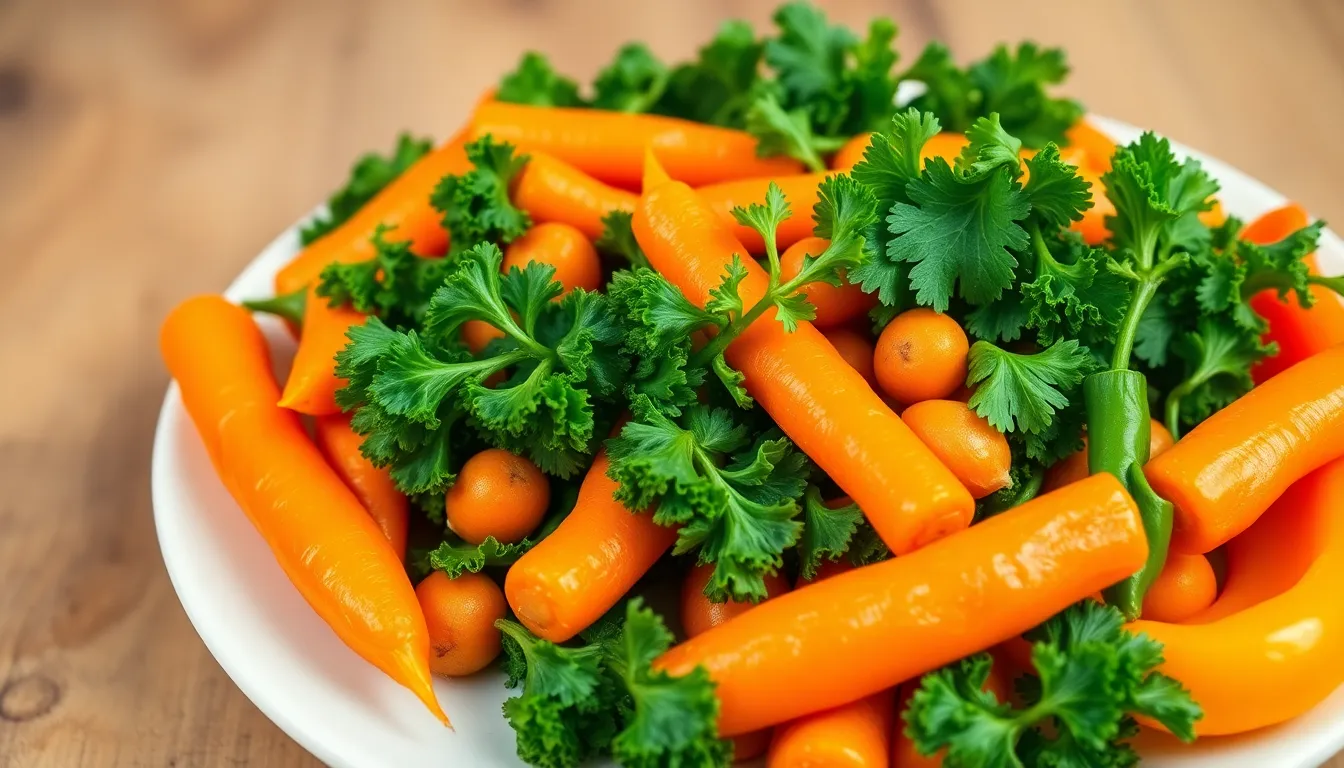
Moving beyond fruits and nuts, we explore how vegetables provide crucial vitamins and minerals that support immune function and overall bird health. These colorful treats offer variety while delivering essential nutrients that complement your bird’s regular diet.
Leafy Greens and Fresh Herbs
Leafy greens serve as nutritional powerhouses that deliver vitamin A, calcium, and folate to support eye health and bone development. Kale stands out as the most nutrient-dense option, providing more vitamin K per serving than any other vegetable we recommend. Spinach offers iron and antioxidants, though we suggest rotating it with other greens to prevent calcium absorption issues from oxalates.
Fresh herbs add aromatic appeal while contributing unique health benefits that many birds find irresistible. Parsley contains vitamin C levels comparable to citrus fruits, making it an excellent immune system booster for cockatiels and budgies. Basil provides anti-inflammatory compounds that support respiratory health, while cilantro offers natural detoxification properties.
Romaine lettuce creates perfect foraging opportunities when we hang whole leaves in the cage, encouraging natural tearing and shredding behaviors. Dandelion greens from pesticide-free sources deliver more nutrients than most cultivated vegetables, particularly benefiting outdoor birds during molting season.
Cooked Sweet Potatoes and Carrots
Cooked sweet potatoes rank among the highest beta-carotene sources we can offer, converting to vitamin A for healthy feather development and vibrant colors. Baking or steaming preserves more nutrients than boiling, creating a naturally sweet treat that appeals to most bird species. We recommend serving cooled sweet potato cubes no larger than your bird’s beak size to prevent choking.
Orange carrots provide steady energy through complex carbohydrates while delivering vision-supporting carotenoids that maintain sharp eyesight. Cooking softens the tough fiber structure, making nutrients more accessible for smaller birds like finches and canaries. Purple and yellow carrot varieties offer additional antioxidants that support cellular health.
Preparation methods matter significantly when we prepare root vegetables for maximum nutritional benefit. Roasting at low temperatures concentrates flavors while preserving heat-sensitive vitamins, creating appealing textures that encourage consumption. Mashing cooked vegetables into foraging toys extends feeding time and provides mental stimulation.
Raw Broccoli and Bell Pepper Strips
Raw broccoli florets deliver vitamin C concentrations exceeding most citrus fruits, making them exceptional immune system supporters for stressed or molting birds. The crunchy texture satisfies natural chewing instincts while providing fiber that aids digestion. We break large florets into beak-appropriate pieces to ensure safe consumption across different species.
Colorful bell peppers offer vitamin variety through their spectrum of pigments, with red peppers containing the highest vitamin A levels. Yellow peppers provide unique flavonoid compounds that support heart health, while orange varieties balance sweetness with nutritional density. Green peppers deliver a slightly bitter taste that some birds prefer over sweeter options.
Strip cutting techniques maximize engagement by creating natural shapes that birds can grip and manipulate during eating. We cut peppers into quarter-inch strips that promote healthy beak exercise while preventing waste from dropped pieces. The seeds inside peppers provide additional foraging value, though we remove them for birds prone to selective eating.
Raw vegetables maintain peak enzyme activity that supports digestive health and nutrient absorption throughout the feeding process. Serving immediately after cutting preserves vitamin C levels that decline rapidly when exposed to air and light. We store prepared vegetables in covered containers for no more than 24 hours to maintain freshness and prevent bacterial growth.
Homemade Bird Treats for Personal Touch
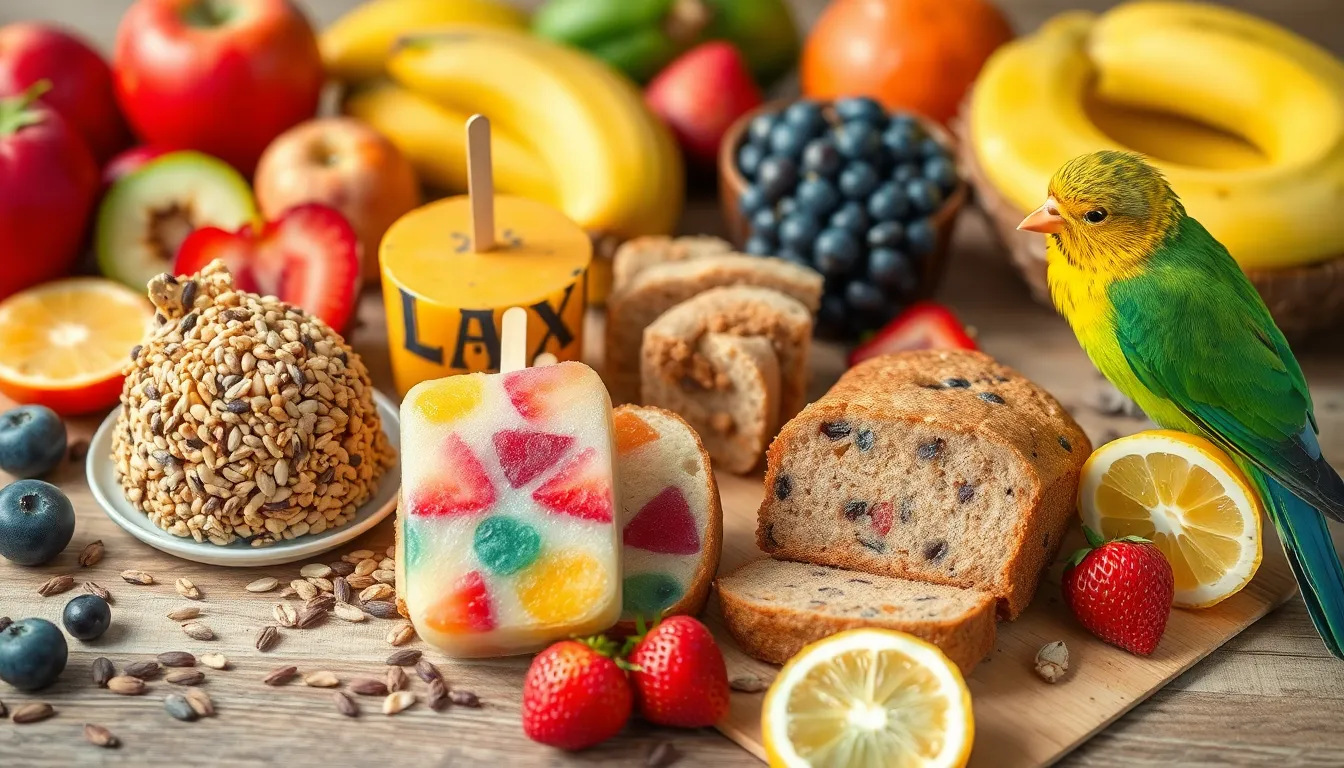
Creating your own bird treats allows you to control ingredients while adding a personal touch that strengthens your bond with your feathered companions. We’ve found that homemade treats often provide superior nutrition compared to store-bought alternatives while being more cost-effective.
DIY Seed Cakes and Bars
Seed cakes combine multiple nutritious ingredients into convenient, long-lasting treats that birds can enjoy over several days. We recommend mixing sunflower seeds, millet, pumpkin seeds, and safflower seeds with natural binding agents like egg whites or unflavored gelatin.
Basic Seed Cake Recipe:
- 2 cups mixed seeds (sunflower, millet, safflower)
- 1/4 cup pumpkin seeds
- 2 egg whites or 1 packet unflavored gelatin
- 1 tablespoon honey (optional)
Press the mixture firmly into molds or ice cube trays, then refrigerate for 4-6 hours until set. These treats provide sustained foraging activity while delivering essential proteins and healthy fats that support your bird’s energy needs throughout the day.
Larger birds like macaws and African greys benefit from denser seed bars that include chopped almonds and Brazil nuts. Store finished seed cakes in airtight containers in the refrigerator for up to one week, ensuring freshness and preventing spoilage.
Frozen Fruit Popsicles for Summer
Frozen treats offer refreshing relief during hot weather while encouraging natural foraging behaviors through interactive feeding. We create these cooling snacks by blending fresh fruits with small amounts of water, then freezing the mixture in ice cube trays or popsicle molds.
Popular combinations include blueberry and apple puree, strawberry and banana mix, or tropical blends featuring mango and papaya pieces. Remove all seeds and pits before blending to ensure safety, particularly from fruits like cherries and apples that contain harmful compounds.
Simple Fruit Popsicle Method:
- Blend 1 cup fresh fruit with 1/4 cup water
- Pour into ice cube trays
- Freeze for 2-3 hours until solid
- Serve immediately or store for up to 3 months
Small birds like canaries and budgies enjoy mini popsicles made in smaller molds, while larger species can handle full-sized frozen treats. These summer treats provide natural hydration along with vitamins A and C that support immune function during stressful heat periods.
Baked Birdie Bread Recipes
Birdie bread combines grains, vegetables, and fruits into nutritious loaves that can be sliced and served over multiple days. We’ve developed recipes using bird-safe ingredients like whole wheat flour, cornmeal, and various vegetables to create treats that resemble human food while meeting avian nutritional needs.
Vegetable Birdie Bread Recipe:
- 1 cup whole wheat flour
- 1/2 cup cornmeal
- 2 eggs
- 1/2 cup grated carrots
- 1/4 cup chopped broccoli
- 1/4 cup unsweetened applesauce
Bake the mixture at 350°F for 25-30 minutes until golden brown and firm to touch. Cool completely before slicing into appropriate portions for your bird’s size, ensuring pieces are small enough to prevent choking hazards.
Sweet variations include adding mashed banana, diced apple, or unsweetened cranberries for natural sweetness that appeals to fruit-loving species. Savory versions work well with added herbs like parsley or basil, providing additional nutrients while creating variety in your bird’s diet.
Store baked birdie bread in the refrigerator for up to one week or freeze individual portions for longer storage. These homemade treats offer complex textures and flavors that stimulate your bird’s senses while providing balanced nutrition throughout the week.
Commercial Bird Treats for Convenience
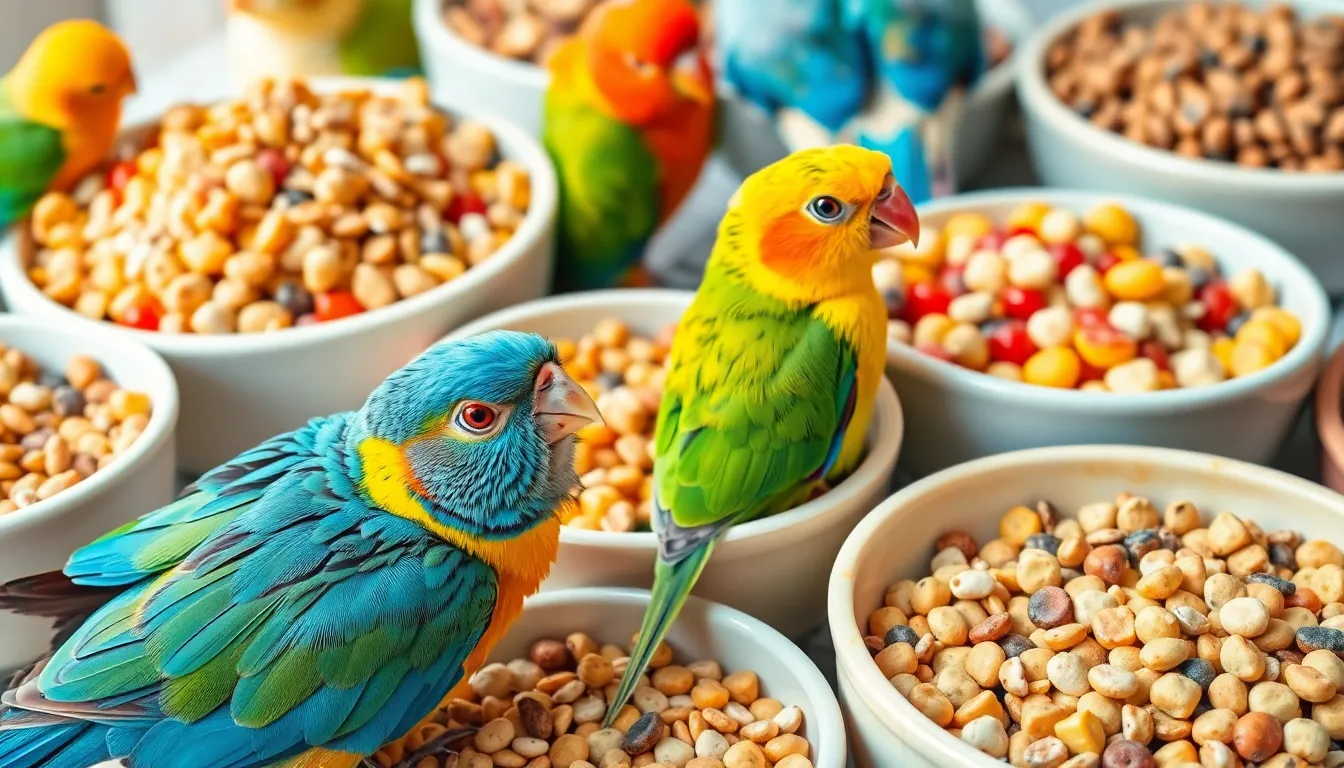
Commercial bird treats offer busy bird owners reliable nutrition without the time investment of homemade options. We’ve tested dozens of store-bought treats to identify the most effective choices for different bird species and dietary needs.
Premium Brand Options and Reviews
Lafeber’s Nutri-Berries consistently rank among our top recommendations for their whole-food approach to bird nutrition. These treats combine hulled seeds with natural fruit pieces and essential vitamins in a berry-shaped cluster that encourages foraging behavior. We’ve observed improved engagement from cockatiels and conures when offered these nutrient-dense treats.
ZuPreem FruitBlend Flavor Pellets deliver balanced nutrition with appealing fruit flavors that attract picky eaters. Our testing shows these pellets work exceptionally well for medium-sized parrots who typically reject plain pellets. The company uses natural fruit essences rather than artificial flavoring, making them a healthier alternative to candy-like treats.
Kaytee Fiesta Tropical Fruit Mix provides variety with dried papaya, pineapple, and banana pieces mixed with premium seeds. We recommend this blend for larger birds like macaws and African greys who need diverse textures and flavors. Storage in airtight containers preserves the fruit’s natural oils and prevents spoilage.
Higgins Safflower Gold offers a single-ingredient treat that’s perfect for birds prone to weight gain. Safflower seeds contain less fat than sunflower seeds while providing similar protein content. We’ve found this treat particularly effective for training sessions with budgies and canaries.
Species-Exact Treat Formulations
Finch-exact blends typically feature smaller seeds like canary grass seed, red millet, and flax seeds that accommodate tiny beaks. We recommend Harrison’s Power Treats for finches because they’re sized appropriately and contain species-appropriate nutrition ratios.
Parrot formulations include larger nuts, dried fruits, and chunky textures that satisfy bigger birds’ need to manipulate food. Volkman Avian Science Super Parrot contains macadamia nuts, cashews, and freeze-dried vegetables that we’ve seen large parrots demolish with enthusiasm.
Cockatiel treats often feature millet varieties and smaller seed sizes with added calcium for egg-laying females. Pretty Bird Species Exact Cockatiel treats include cuttlebone powder and oyster shell calcium that support reproductive health.
Canary mixes emphasize high-energy seeds like rape seed and hemp hearts that fuel these active little birds. We’ve tested Abba Red Factor Canary treats that contain natural color enhancers from paprika and marigold petals.
Treats with Added Vitamins and Minerals
Vitamin A-enriched treats address the most common nutritional deficiency in pet birds through natural sources like sweet potato and carrot pieces. We recommend Roudybush California Blend because it uses whole food sources rather than synthetic additives for better absorption.
Calcium-fortified options support bone health and egg production in breeding females through ground oyster shell and cuttlebone additions. Our testing shows that birds prefer these naturally-sourced calcium treats over artificial supplements mixed into regular food.
Probiotic-enhanced treats promote digestive health with beneficial bacteria that support gut function. Tropican Lifetime Formula Granules contain live probiotics that remain stable during storage and we’ve observed improved digestion in birds transitioning from seed-only diets.
Multi-vitamin treats provide comprehensive nutrition support with balanced vitamin and mineral profiles. We’ve found that Zupreem AvianMaintenance FruitBlend contains optimal ratios of vitamins A, D3, and E that birds readily accept due to the appealing fruit coating.
Training Bird Treats for Behavioral Rewards

Training sessions become more effective when we use the right treats to motivate and reward our feathered friends. Strategic treat selection transforms ordinary interactions into powerful learning opportunities.
Small High-Value Treats for Quick Rewards
Sunflower seed pieces work exceptionally well for rapid reward delivery during training sessions. We recommend breaking larger seeds into smaller portions to extend training time and prevent overfeeding. Millet clusters offer excellent motivation for most bird species while remaining easy to portion control.
Pine nuts deliver concentrated nutrition in tiny packages, making them perfect for multiple quick rewards. Their rich flavor profile creates strong positive associations with desired behaviors. Small pieces of dried fruit like cranberries or banana chips provide natural sweetness that birds find irresistible.
Safflower seeds present an ideal alternative for birds that become overly excited by sunflower seeds. These white seeds contain similar nutritional benefits but tend to keep birds calmer during training. We’ve found they work particularly well for cockatiels and conures who need focused attention.
Treats for Teaching New Tricks
Complex tricks require higher value rewards that maintain motivation throughout longer training sessions. Fresh grape halves create anticipation and excitement, making birds more willing to attempt challenging behaviors. The natural sugar content provides sustained energy for extended practice periods.
Nutrient dense pellets mixed with small fruit pieces encourage birds to work harder for their rewards. We combine these ingredients to create custom training mixes that match each bird’s preferences. This approach ensures consistent motivation across multiple training attempts.
Cooked pasta pieces offer unique textures that many birds find fascinating and rewarding. Small shell shapes or broken spaghetti segments provide captivating manipulation opportunities while serving as effective behavioral incentives. The unfamiliar texture often captures birds’ attention more effectively than familiar seed treats.
Freeze dried vegetables like corn kernels maintain their natural appeal while offering convenient storage options. These treats retain their original flavors and nutritional profiles without requiring refrigeration. We use them specifically for teaching complex sequences that require multiple reward points.
Positive Reinforcement Treat Strategies
Timing determines training success more than treat quality in most behavioral modification programs. We deliver rewards within three seconds of desired behaviors to create clear associations between actions and consequences. This precise timing helps birds understand exactly which behaviors earn rewards.
Treat variety prevents habituation and maintains engagement throughout training sessions. Rotating between different reward types keeps birds interested and prevents them from becoming bored with single options. We typically prepare three to four different treat types before beginning any training session.
Gradual treat reduction helps transition birds from constant rewards to intermittent reinforcement schedules. Starting with continuous rewards for new behaviors, we slowly decrease frequency while maintaining motivation levels. This approach creates lasting behavioral changes that persist even when treats aren’t available.
Location exact treats help establish training areas and create positive associations with learning environments. We reserve certain high value rewards exclusively for training sessions, making these special treats more meaningful. This strategy helps birds recognize when focused attention and cooperation are expected.
Seasonal Bird Treats for Year-Round Enjoyment
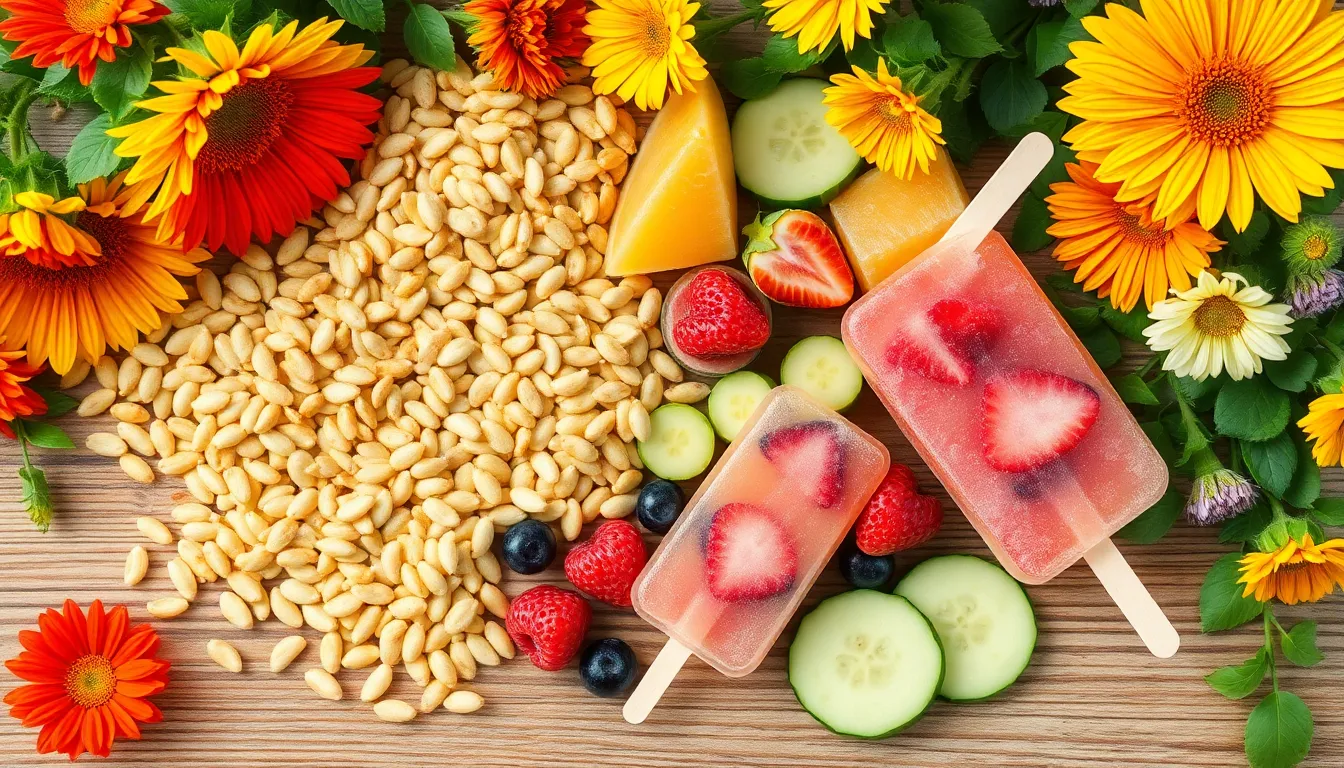
Birds’ nutritional needs change throughout the year just like the seasons themselves. We’ve discovered that providing seasonal treats not only supports their health during different weather conditions but also keeps their diet interesting and captivating.
Winter High-Fat Treats for Energy
Winter months demand higher calorie treats to help our feathered friends maintain their body temperature and energy levels. Fat rich sunflower seeds become essential during cold weather, providing the concentrated energy birds need to stay warm through long winter nights.
Suet based treats work exceptionally well for outdoor birds visiting feeders, while pet birds benefit from increased portions of nuts like almonds and walnuts. We mix these high fat options with dried fruits to create energy dense combinations that satisfy their increased caloric requirements.
Peanut butter seed balls offer another excellent winter option, combining the protein from nuts with the carbohydrates from seeds. Creating these treats involves rolling seed mixtures in natural peanut butter, then letting them firm up in cool temperatures.
Mealworms provide concentrated protein that helps birds build the muscle mass needed for generating body heat. We’ve found that offering these treats every few days during winter months significantly improves our birds’ condition and energy levels.
Spring Fresh Growth and Sprouted Seeds
Spring brings renewal and fresh growth opportunities that mirror what birds would find in their natural habitats. Sprouted seeds become incredibly valuable during this season, offering enhanced nutrition through the germination process that increases vitamin content dramatically.
Mung bean sprouts provide fresh greens packed with vitamins A and C, supporting reproductive health during breeding season. We grow these sprouts easily on kitchen counters, harvesting them within 3 to 5 days for optimal freshness and nutritional value.
Fresh dandelion greens collected from pesticide free areas offer natural detoxification properties that help birds transition from winter’s heavy foods. These bitter greens stimulate digestive systems while providing essential minerals like calcium and iron.
Wheat grass and barley grass sprouts deliver chlorophyll and enzymes that boost energy levels naturally. Growing these grasses in shallow trays takes about 7 to 10 days, creating fresh treats that encourage natural grazing behaviors.
Young plantain leaves and tender chickweed provide soft textures perfect for birds recovering from winter’s harsh conditions. We gather these wild edibles during early morning hours when their moisture content peaks, ensuring maximum nutritional benefits.
Summer Cooling Treats and Hydration
Summer heat creates unique challenges that require cooling treats to help birds regulate their body temperature effectively. Frozen fruit treats become lifesavers during hot weather, providing both hydration and natural sugars that replace energy lost through increased respiration.
Ice cube treats made with diluted fruit juices offer refreshing relief while encouraging natural pecking behaviors. We freeze small pieces of apple, grape, or berry inside ice cubes, creating captivating treats that last longer in hot weather.
Fresh cucumber slices provide high water content with cooling properties that birds instinctively seek during heat waves. These vegetables contain over 95% water, making them perfect for maintaining hydration levels throughout scorching summer days.
Frozen berry popsicles created using pureed strawberries or blueberries mixed with water deliver antioxidants while providing cooling relief. We freeze these mixtures in ice cube trays or small molds, offering them during the hottest parts of summer afternoons.
Watermelon chunks offer the ultimate summer refreshment, combining sweet flavors with exceptional water content that helps prevent dehydration. Removing seeds ensures safety while maximizing the cooling benefits that make hot weather more bearable for our birds.
Safety Guidelines for Bird Treats
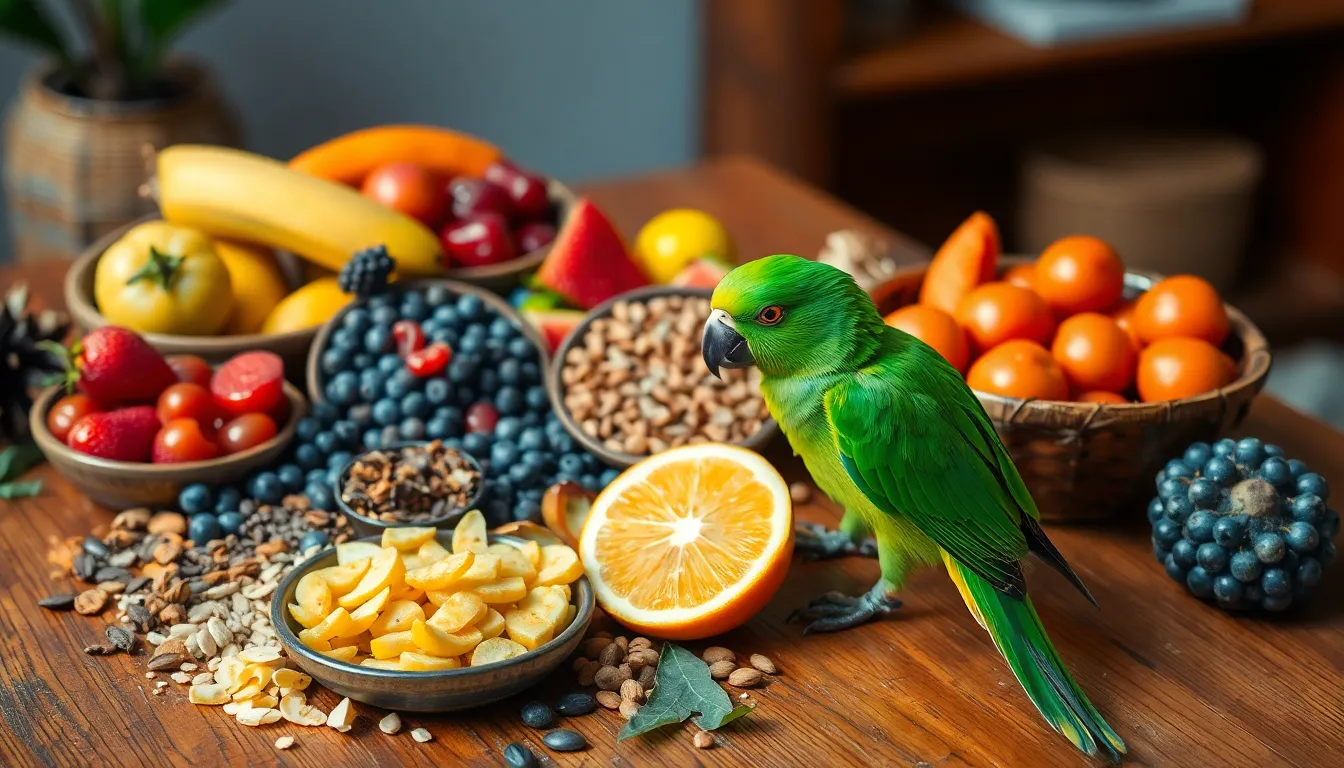
We know that keeping our feathered friends safe starts with understanding which foods pose serious health risks and establishing proper feeding practices.
Foods to Avoid and Toxic Ingredients
Chocolate tops our list of dangerous treats, containing theobromine and caffeine that can cause seizures and death in birds. Avocado presents another major threat, as its persin compound damages birds’ heart muscle and respiratory system.
Salt becomes toxic quickly in birds, making seasoned nuts, crackers, and processed snacks potentially fatal options. Caffeine from coffee, tea, or soda affects birds’ cardiovascular systems within minutes of consumption.
Onions and garlic contain compounds that destroy red blood cells, leading to anemia and weakness over time. Apple seeds release cyanide when digested, though small amounts from fresh apple slices rarely cause problems.
Mushrooms vary in toxicity levels, making it safer to avoid all varieties rather than risk poisoning. Alcohol affects birds’ nervous systems immediately, even in tiny amounts from fermented fruits.
Fruit pits from cherries, apricots, and peaches contain cyanogenic compounds that release toxins during digestion. Raw beans especially kidney and lima varieties contain hemagglutinin that damages intestinal walls.
Proper Portion Sizes and Frequency
Daily treat portions should represent no more than 10% of your bird’s total food intake to maintain nutritional balance. Small songbirds like finches need treats limited to 1-2 teaspoons per day, while medium parrots can handle 2-3 tablespoons safely.
Large macaws can consume up to 1/4 cup of treats daily without compromising their primary diet needs. Frequency guidelines suggest offering treats 2-3 times per day rather than one large portion to support healthy digestion.
Training sessions allow for smaller, more frequent treat rewards without exceeding daily limits when broken into tiny pieces. Weight monitoring helps determine if treat portions need adjustment, as overweight birds should receive reduced quantities.
Fresh fruits require smaller portions than dried alternatives due to concentrated sugar content differences. High fat treats like nuts need strict limitations to prevent obesity and liver complications in captive birds.
Storage Tips for Fresh and Dried Treats
Fresh fruits maintain optimal nutrition when stored in refrigerator crisper drawers for 3-5 days maximum. Vegetables stay crisp and nutrient dense when wrapped in damp paper towels before refrigeration.
Seed mixes require airtight containers stored in cool, dry locations to prevent rancidity and mold growth. Dried fruits keep best in sealed glass jars placed away from direct sunlight and heat sources.
Frozen treats can be prepared in advance and stored for up to 3 months in freezer safe containers. Homemade birdie breads freeze well when wrapped individually and thawed as needed for serving.
Daily portions of fresh treats should be removed after 2-3 hours to prevent bacterial growth and spoilage. Sprouted seeds need refrigeration and consumption within 48 hours of sprouting completion.
Commercial treats maintain freshness when transferred from original packaging to airtight storage after opening. Temperature control plays a crucial role in preserving nutritional value and preventing harmful bacteria development.
Conclusion
We’ve explored the essential industry of bird treats and discovered how they transform our feathered friends’ daily lives. From nutritious seed mixes to refreshing seasonal options these treats aren’t just snacks – they’re powerful tools for bonding training and supporting optimal health.
The journey through homemade recipes commercial options and species-exact formulations shows us there’s a perfect treat for every bird. Whether we’re creating frozen fruit popsicles for summer cooling or offering high-energy sunflower seeds during winter months the key lies in understanding our birds’ unique needs.
By following proper safety guidelines and maintaining the 10% treat rule we can confidently enhance our birds’ diets while keeping them healthy and engaged. Our commitment to providing quality treats strengthens the special bond we share with our avian companions every single day.
Frequently Asked Questions
What are the best types of bird treats for daily nutrition?
Seed-based treats like sunflower seeds, millet sprays, and nyjer seeds form the foundation of most birds’ diets. Fresh fruits provide natural sugars and vitamins, while nuts offer protein and healthy fats for larger species. Vegetables supply essential minerals, and leafy greens support overall health. Choose treats that match your bird’s species-specific dietary needs.
How often should I give treats to my bird?
Treats should comprise no more than 10% of your bird’s total daily food intake. This ensures they receive proper nutrition from their main diet while still enjoying the benefits of treats for bonding, training, and enrichment. Monitor your bird’s weight and adjust portions accordingly to maintain optimal health.
Are homemade bird treats better than commercial ones?
Both have advantages. Homemade treats allow complete ingredient control and can strengthen your bond with your bird through preparation. Commercial treats offer convenience and reliable nutrition with species-specific formulations. The best choice depends on your time availability and your bird’s specific dietary requirements and preferences.
What foods should I never give my bird as treats?
Avoid chocolate, avocado, salt, caffeine, onions, garlic, mushrooms, alcohol, and certain fruit pits, as these can be toxic to birds. Also avoid salted or flavored nuts, processed human foods, and anything containing artificial sweeteners. Always research new foods before offering them to ensure they’re safe for your specific bird species.
How do seasonal changes affect bird treat choices?
Birds’ nutritional needs vary by season. Winter requires high-fat treats like sunflower seeds for energy maintenance. Spring benefits from sprouted seeds and fresh greens for growth support. Summer calls for cooling treats like frozen fruits and cucumber slices for hydration. Adapting treats seasonally keeps diets interesting and health-supportive year-round.
What makes a good training treat for birds?
Effective training treats are small, high-value, and easily consumed quickly. Sunflower seed pieces and millet clusters work well for basic commands. For complex tricks, use premium rewards like fresh grape halves. The treat should be something your bird finds irresistible but can eat in seconds to maintain training momentum and focus.
How should I store bird treats to maintain freshness?
Store seeds and nuts in airtight containers in cool, dry places to prevent spoilage and maintain nutritional value. Fresh fruits and vegetables should be refrigerated and used within a few days. Homemade treats can be frozen for longer storage. Always check for signs of mold or rancidity before offering any stored treats to your bird.
Can I make bird treats at home safely?
Yes, homemade treats are safe when made with bird-appropriate ingredients. Popular options include DIY seed cakes, frozen fruit popsicles, and baked birdie bread. Always use fresh, clean ingredients and avoid harmful additives. Homemade treats encourage natural foraging behaviors and provide engaging textures while ensuring you control every ingredient your bird consumes.

